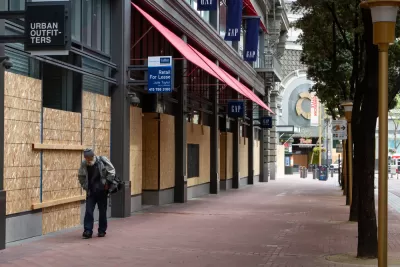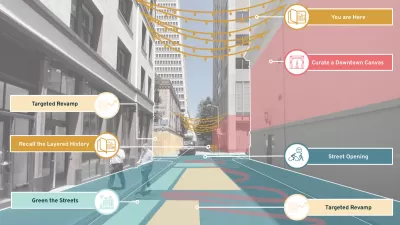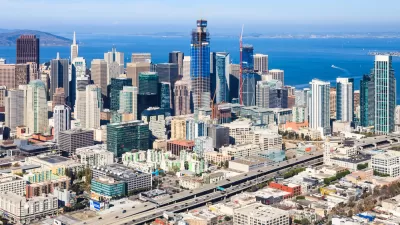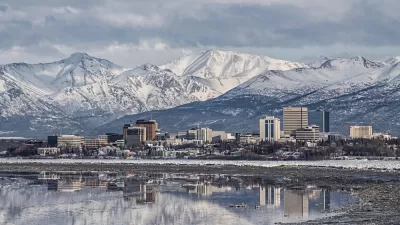A nonprofit business group released a plan to trigger the post-pandemic revitalization of Downtown San Francisco by reclaiming public space for human scale activity. But is an improved public realm sufficient to meet the challenge?

A nonprofit business group called the Downtown SF Partnership recently released the Public Realm Action Plan, created in collaboration with SITELAB urban design studio, Fehr + Peers, and John Bela, in the hopes of enticing people back to Downtown San Francisco with a less car-centric approach to the public realm.
According to a paywalled article by Noah Arroyo for the San Francisco Chronicle, the Public Realm Action Plan (PRAP) provides a development template for a part of city drastically affected by the Covid-19 pandemic in need of a comeback, with office vacancies staying stubbornly high as many tech industry companies shift to part-time and full-time remote work and residents decamp for more suburban climes. The PRAP would “entice office workers, tourists and others back to the area by revamping the landscape — closing streets to car traffic, fostering frequent outdoor events and green space, and otherwise making the area more attractive,” writes Arroyo.
As explained on its website, the PRAP Plan focuses on six action areas, comprising 43 blocks across Downtown San Francisco’s Financial District and Jackson Square Historic District.
As noted by Arroyo, the city has promised to release a downtown revitalization plan of its ow, but so far, “few specifics have emerged beyond $8 million in Mayor London Breed’s recent budget proposal for overall downtown revitalization.” The PRAP was created without a formal partnership with city leadership.
For an initial critical assessment of the PRAP, see a paywalled column by San Francisco Chronicle Urban Design Critic John King expressing skepticism about the potential of the PRAP to trigger the revitalization sought by Downtown San Francisco stakeholders.
“If you want a handy guide to the small-scale interventions that are in vogue these days for urban America — from parklets to pop-ups to cultural programming,” the PRAP is a useful document, writes King. “If you also want a document that offers a realistic blueprint for bringing the city’s Financial District back to life, keep looking.”
King offers plenty to credit the effort behind the PRAP, but the document can’t overcome a fundamental challenge facing Downtown San Francisco (and urban commercial cores in many other cities around the country): “What frames negative perceptions of the Financial District right now are empty storefronts and mostly vacant high-rises, not the lack of shady trees or lunchtime concerts.”
Planetizen picked up the news about the launch of the PRAP process in November 2021.
FULL STORY: Is this the future of downtown San Francisco? [paywall]

Trump Administration Could Effectively End Housing Voucher Program
Federal officials are eyeing major cuts to the Section 8 program that helps millions of low-income households pay rent.

Planetizen Federal Action Tracker
A weekly monitor of how Trump’s orders and actions are impacting planners and planning in America.

Ken Jennings Launches Transit Web Series
The Jeopardy champ wants you to ride public transit.

California Invests Additional $5M in Electric School Buses
The state wants to electrify all of its school bus fleets by 2035.

Austin Launches $2M Homelessness Prevention Fund
A new grant program from the city’s Homeless Strategy Office will fund rental assistance and supportive services.

Alabama School Forestry Initiative Brings Trees to Schoolyards
Trees can improve physical and mental health for students and commnity members.
Urban Design for Planners 1: Software Tools
This six-course series explores essential urban design concepts using open source software and equips planners with the tools they need to participate fully in the urban design process.
Planning for Universal Design
Learn the tools for implementing Universal Design in planning regulations.
Ada County Highway District
Clanton & Associates, Inc.
Jessamine County Fiscal Court
Institute for Housing and Urban Development Studies (IHS)
City of Grandview
Harvard GSD Executive Education
Toledo-Lucas County Plan Commissions
Salt Lake City
NYU Wagner Graduate School of Public Service





























